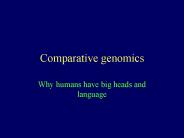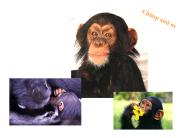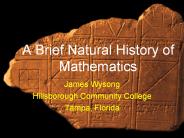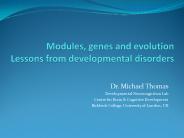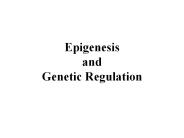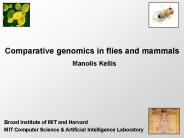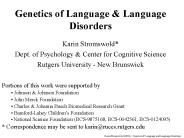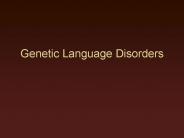Foxp2 PowerPoint PPT Presentations
All Time
Recommended
... the amino acid sequences encoded by these primate mRNAs to the human protein. ... Rodents and primates trace their common ancestor back to about 80-110 ...
| PowerPoint PPT presentation | free to download
Chapter 21 Genomes and Their Evolution * Figure 21.17 Inquiry: What is the function of a gene (FOXP2) that is rapidly evolving in the human lineage?
| PowerPoint PPT presentation | free to download
"Copy Link : gooread.fileunlimited.club/pwjul24/0199329222 How To Think Like a Neandertal Reprint Edition There have been many books, movies, and even TV commercials featuring Neandertals--some serious, some comical. But what was it really like to be a Neandertal? How were their lives similar to or different from ours?In How to Think Like a Neandertal, archaeologist Thomas Wynn and psychologist Frederick L. Coolidge team up to provide a brilliant account of the mental life of Neandertals, drawing on the most recent fossil and archaeological remains. Indeed, some Neandertal remains are not fossilized, allowing scientists to recover samples of their genes--one specimen had the gene for red hair and, more provocatively, all had a gene called FOXP2, which is thought to be related to speech. Given the differences between their faces and ours, their voices probably sounded a bit different, and the range of consonants and vowels they c"
| PowerPoint PPT presentation | free to download
The evolution of speech Humans uniquely have a complex oral communication capability based on speech and speech recognition. This trait has allowed our species to ...
| PowerPoint PPT presentation | free to download
Review, Elman Lecture COGS 1 winter 08 Adrienne Moore 3-12-08
| PowerPoint PPT presentation | free to view
Title: Pr sentation PowerPoint Author: LGM Last modified by: LGM Biologie Created Date: 9/20/2003 10:19:10 AM Document presentation format: Pr sentation l' cran
| PowerPoint PPT presentation | free to view
Renvoie chez l 'adulte l 'apraxie bucco-faciale ou bucco-phonatoire qui se manifeste l ' tat pur comme dans l 'anarthrie ou l 'aphasie de Broca. ...
| PowerPoint PPT presentation | free to view
... the segmentation gene ftz(fushi tarazu) and the homeotic gene Antp. ... Many homeotic regulatory proteins interact with Exd and bind a composite Exd-Hox ...
| PowerPoint PPT presentation | free to view
Experimental manipulations that alter animal morphology ... The loss of abdominal limbs in insects is due to functional ... Ciona FGFs: orange; 6 Vertebrate ...
| PowerPoint PPT presentation | free to download
Title: 233 Brain & Behaviour: 1. Introduction Author: lauwerja Last modified by: Jan Lauwereyns Created Date: 2/26/2004 11:51:29 PM Document presentation format
| PowerPoint PPT presentation | free to view
The basal ganglia mediates adulthood sensorimotor adaptive plasticity. human speech / language Broca s area Wernicke s area ... the neuroanatomy of speech and ...
| PowerPoint PPT presentation | free to download
Genome browser: http://genome.cse.ucsc.edu/ Homologene: http://www.ncbi.nlm. ... Compare humans with macaque monkeys (primates), and rats with mice (rodents) ...
| PowerPoint PPT presentation | free to download
22% (=Eu4, 9, 10, 11); Semino et al. (2000) Science 290, 1155-1159 ... Forster P (2004) Ice Ages and the mitochondrial DNA chronology of human dispersals: a review. ...
| PowerPoint PPT presentation | free to download
Cognitive Disabilities
| PowerPoint PPT presentation | free to download
Example: tiger pufferfish (Fugu rubripes), mouse (Mus musculus), and human genomes ... 25% human genes no counterparts in Fugu ...
| PowerPoint PPT presentation | free to view
What makes us human? Katherine S. Pollard Gladstone Institutes, Institute for Human Genetics and Division of Biostatistics - UCSF http://docpollard.com
| PowerPoint PPT presentation | free to download
Chimp and us At the sequence level (coding sequence level) Nucleotide divergence: 1.23 % 14-22 % of these differences are due to polymorphism - fixed divergence rate ...
| PowerPoint PPT presentation | free to download
... is very Similar o that of the Mouse and Virtually Identical to the Chimp ... Between the chimp and human,they vary by an average of just 2%squence divergence. ...
| PowerPoint PPT presentation | free to view
'When measurement replaces observation, calculation replaces debate.' S.S. Stevens ... The American Journal of Human Genetics, 79, 965-972. ...
| PowerPoint PPT presentation | free to view
... in humans due to mutation in CMP-sialic acid hydroxylase (Chou et al. PNAS 95(20) ... Mutation in a Siglec (sialic acid receptor) (Angata et al. JBC 276:40282-7) ...
| PowerPoint PPT presentation | free to download
Announcement: part-time dishwasher position available in the Medical School; ... Cro magnum. Chrome magnum. 500,000 yrs ago brain size increased significantly. ...
| PowerPoint PPT presentation | free to view
The Human Genome and Human Evolution Y Chromosome Dr Derakhshandeh, PhD Outline Information from fossils and archaeology Neutral (or assumed-to-be-neutral) genetic ...
| PowerPoint PPT presentation | free to view
Genomic organization and functional characterization of regulatory elements in higher eukaryotes Boris Lenhard Computational Biology Unit Bergen Center for ...
| PowerPoint PPT presentation | free to view
The misexpression of the crustacean Ubx protein in transgenic flies does not ... Ubx in crustaceans, the C-terminal antirepression peptide blocks the activity of ...
| PowerPoint PPT presentation | free to view
A Brief Natural History of Mathematics
| PowerPoint PPT presentation | free to view
Dr. Michael Thomas Developmental Neurocognition Lab Centre for Brain & Cognitive Development Birkbeck College, University of London, UK COMT catechol-O-methyl ...
| PowerPoint PPT presentation | free to download
Title: Structure and evolution of plant sex chromosomes Author: Administrator Last modified by: Eduard Kejnovsk Created Date: 2/5/2004 1:54:08 PM
| PowerPoint PPT presentation | free to download
Middle Stone Age technology in Australia ~50 KYA ... Stone Age. Upper Paleolithic ~130. KYA ... The human Y chromosome: an evolutionary marker comes of age. ...
| PowerPoint PPT presentation | free to view
4) Photocopy (Transcriptional) Regulation. 5) Packaging (Post-Translational) Regulation ... At fertilization, both X chromosomes are active. ...
| PowerPoint PPT presentation | free to download
Comparative genomics in flies and mammals Manolis Kellis Broad Institute of MIT and Harvard MIT Computer Science & Artificial Intelligence Laboratory
| PowerPoint PPT presentation | free to download
Genetics of Language & Language Disorders Karin Stromswold* Dept. of Psychology & Center for Cognitive Science Rutgers University - New Brunswick
| PowerPoint PPT presentation | free to download
Neanderthals. Noonan, et al. Sequencing and Analysis of ... Most closely related hominid group to modern humans. First recognized 150 ... 1-800-BUTTERBALL ...
| PowerPoint PPT presentation | free to view
Human origins and evolution Gil McVean, Department of Statistics, Oxford Questions about human origins What defines a human? What does the fossil record tell us?
| PowerPoint PPT presentation | free to download
and we want to know how similar they are. What is the basis for their ... Dating of the human-ape splitting by a molecular clock of mitochondrial DNA. J. Mol. ...
| PowerPoint PPT presentation | free to view
World Atlas of Language Structures. Dryer's map on Case. VO and OV ... The World Atlas of Language Structures. Hauser, Marc, Noam Chomsky, & Tecumseh Fitch 2002. ...
| PowerPoint PPT presentation | free to view
can trace their mitochondrial lineages (how long ago lived the very great. grandmother of everyone alive today)? 32,000 years. 150,000 years. 3.2 million years ...
| PowerPoint PPT presentation | free to view
'celui qui ne parle pas bien, qui est sans loquence ; et c'est ensuite celui qui ... Facteurs acquis ou relevant de la culture. Th ories de l'APPRENTISSAGE ...
| PowerPoint PPT presentation | free to view
Genomics: bridge from Lecture 8 tools
| PowerPoint PPT presentation | free to view
... Only crucial for acquiring spoken language ... Teach sign language exclusively (at least at first) ... through the same stages as in spoken language ...
| PowerPoint PPT presentation | free to download
The seven sides are self-love, love of others, loving good, loving life, loving harm, memories and hopes. This model adds our heritage - memories and hopes, ...
| PowerPoint PPT presentation | free to download
Sapir-Whorf Hypothesis The language a person uses determines their perception of reality. Different languages classify experiences differently.
| PowerPoint PPT presentation | free to download
But, according to evolutionary theory, you and a monkey have common ancestors (way, way back) ... Sidebar: Anti-Evolutionary Creationists. Can be both lumpers ...
| PowerPoint PPT presentation | free to view
AP Ch 18 Regulation of Gene Expression * * * * Figure 21.16 Evolutionary relationships of the three domains of life. * * * * * Figure 21.17 Inquiry: What is the ...
| PowerPoint PPT presentation | free to view
Psych 56L/ Ling 51: Acquisition of Language Lecture 16 Language in Special Populations * * * * * * * * * * * * * * * * * * * * * * * * Language in Higher-Functioning ...
| PowerPoint PPT presentation | free to download
Etiopatogenia de las alucinaciones auditivas en las psicosis. ... grave (incoordinaci n motora del habla, discapacidad para imitar sonidos) ...
| PowerPoint PPT presentation | free to view
Genetic Language Disorders Pervasive Problem 8-12% of school-age children have delayed -or- disordered communicative development (National Institutes of ...
| PowerPoint PPT presentation | free to download
mapping genes and sequencing the DNA. ... The Personal Genome Project The largest current coordinated project to get useful medical info from human genomics is run ...
| PowerPoint PPT presentation | free to download
Title: Sikela lab research Author: James Sikela Last modified by: James Sikela Created Date: 8/18/2006 8:15:27 PM Document presentation format: On-screen Show
| PowerPoint PPT presentation | free to view
Jay Keasling (Berkeley): biofuel, anti-malarial treatment ... IBM Blue Brain: multidisciplinary advances. Neocortical anatomy and microscopy recording ...
| PowerPoint PPT presentation | free to view
PowerPoint Presentation
| PowerPoint PPT presentation | free to download
CHAPTER 10 The Nature of the Gene and the Genome Sequencing Genomes: The Footprints of Biological Evolution (5) Structural Variation Segments of the genome can change ...
| PowerPoint PPT presentation | free to download
Life: The Science of Biology, 10e ... Genomes
| PowerPoint PPT presentation | free to download
Title: PowerPoint Presentation Last modified by: Microsoft Created Date: 1/1/1601 12:00:00 AM Document presentation format: Presentaci n en pantalla
| PowerPoint PPT presentation | free to view
Monkeys and apes have opposable thumbs, meaning they can touch the ventral ... a collision between the Indian and Asian tectonic plates about 10 million years ago. ...
| PowerPoint PPT presentation | free to view
... Gibbs on epigenetics Punctual papers Somerville et al. on Williams syndrome Fisher on genes ... The reference conceptual model: ... A central reflection, ...
| PowerPoint PPT presentation | free to view



![[PDF] How To Think Like a Neandertal Reprint Edition Full PowerPoint PPT Presentation](https://s3.amazonaws.com/images.powershow.com/10079859.th0.jpg)








